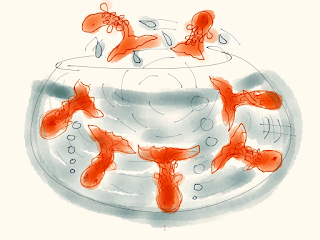By Keith Tidman
What Is It to Be Us?
Pi departs from its usual prose format to offer a poem that probes the oldest philosophical question of them all: Know Thyself. What makes us, us—what “lights the fire that animates us”? It’s a look at the unique cycle of our experiences as a conscious, complexly intelligent, inquisitive, and contemplative species. Our minds pondering themselves ... and beyond. The account briefly reconnoiters some of what’s key to defining who we are, across dimensions both “mind-boggling and sundry”: experience and empiricism, awareness, reality and truth, illusions (“gossamer ghosts”), identity, consciousness, ethics (“what morally ought”), free will and determinism, theism, language and logic, knowledge and uncertainty, purpose and meaning, cosmos, curiosity and reflection, and nothingness. As well as widening the aperture on who we are by deliberating on our place in the larger cosmic plateau. Where some people pensively envision a universe “made for us by a designer with palette in hand”; whereas others turn to secular explanations that still satisfy the telltale parameters of non-contingency, necessity, and sufficiency.
Galvanized by the continual onrush of sensory cues from surroundings’ presence,
our empirical awareness of the world wends tentacle-like through the fabric of the mind;
In zealous search of knowable realities we hope will garner life’s welcome reassurance,
yet us not uncommonly hampered by chancing upon a knotty metaphysical bind.
The gauzy filaments of objective truth elude our mind’s guarding praetorian presence,
shrouded ambiguously by our invention of reality's illusory, gossamer ghosts;
All the while we clutch white-knuckled to delusions’ hoped-for objective essence,
grasping for a reality unedited by the mind, but which may prove mythological at most.
We wonder what trustily dwells within and lights the fire that animates us,
perhaps it’s what we ourselves choose as a resolutely self-aware identity;
Or perhaps alternatively a fated version of us we hesitate to discuss above a hush,
rather than the emergent mind as an uncannily separate, ethereally otherworldly entity.
The notion of consciousness eerily estranged from the body is arguably for naught,
a polarity of where the mind resides that’s urged on us by those materialism repels;
Yet society’s dogmas compete to piously press upon us ‘what morally ought,’
to accede to the illusion of unshackled, libertarian free agency that determinism dispels.
This ‘ought,’ clued-up by our foreboding mortality, spurs us to ferret out purpose,
where the ethical intent of humanism’s ideals aim to render our community less savage;
And true humanity defies dystopia’s pounding on the door with callous,
where the point–counterpoint between secularism and theism is vain baggage.
In anthropomorphizing divinities for purposes of iconography and relatability,
we paradoxically deify ourselves, where shared attributes whisper of a oneness;
But such false equivalency denotes our species in hubristic coherence with divinity,
where it’s said entreaties go answered and accountability accedes to forgiveness.
Our identity gets forged on the anvil of natural language and its seminal logic,
hammering into its malleable surface the crux of who we are—what it is to be us ;
The arrow of knowledge bends to best foster understanding and tame the chaotic,
aware of languages’ power and elasticity in drawing the contours of reality thus.
We search, maturing our nascent understanding of the disquieted universe,
imagining the complexity of existence in ways mind-boggling and sundry;
Where thought experiments throw open the door onto new paradigms diverse,
changing knowledge’s landscape, yet where investigation still tarries hungry.
Some dream of a cosmos granularly made for us, by a designer with palette in hand,
but such destiny, as an alluring siren song, risks sounding of vanity unbound;
Therein lie the limits of knowledge, where the certainty of uncertainty is fanned,
and where ideas eclipse the frontiers of realism and commonsense runs aground.
Meantime, we mine and mold our metaphysics for craved significance,
where consciousness and understanding imbue our species with meaning;
We sit astride the sciences and humanities with self-ascribed radiance,
while humbly reminded of the universe as a nursery spawning stars gleaming.
As progeny of star detritus ejected across lightyears by violent supernovas long ago,
humankind is the cosmos probing itself, at which our species indeed excels;
We wonder how it is that natural laws bestow the human mind a clever tableau,
enabling us to ponder the whys and wherefores that therein will always dwell.
The mind stirs tirelessly with fevered curiosity about what’s true and real,
all the while this inborn, foundational quest at its best won’t let us rest;
Not until our expiry time has run its quizzical course and mourning bells peal,
then the nectar of ‘nothingness,’ as the mind wanes within its erstwhile neuronal nest.






